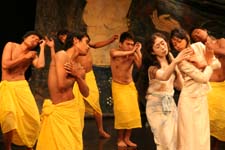
Jack Anderson
NYC Ballet: Concertos, Etc.
New York City Ballet
April 25-June 25, 2006
Tuesdays and Wednesdays at 7:30 p.m., Thursdays and Fridays at 8 p.m.,
Saturdays at 2 and 8 p.m., Sundays at 3 p.m., $30-86
New York State Theater, Lincoln Center
Tickets: (212) 721-6500 or www.nycballet.com
Reviewed by Jack Anderson May 26, 2006
 |
"Let's choreograph a concerto!"
Ever since shifting tastes earlier in the twentieth century made it permissible to use concert music for dances, choreographers have been choreographing concertos. Their appeal is obvious. Most concertos are solid orchestral works in several contrasting movements, each of which may abound with its own internal contrasts.
But concertos can pose problems. Their movements may become separate sonic blocks, making it difficult for choreographers to progress easily from one movement to another. Moreover, composers can give a concerto's solo instrument elaborate cadenzas or other virtuoso sequences that choreographers cannot match. Nevertheless, concertos continue to inspire dances.
Concertos inspired two recent productions in the New York City Ballet's Diamond Project festival. Both received their premieres May 10, and were repeated together, May 20. Neither is a major addition to the repertoire.
In fact, Peter Martins's "The Red Violin" is annoyingly pointless. Like many City Ballet creations, it takes its title from its score: in this case, John Corigliano' s Concerto for Violin and Orchestra ("The Red Violin"). That title, in turn, is an acknowledgment that the concerto includes music Corigliano wrote for the film "The Red Violin," which I never saw, but which, I'm told, chronicles the adventures of a remarkable violin through history.
The ballet jettisons this scenario, and Martins has a perfect artistic right to do so. But he has kept a title which, though intriguing, is totally irrelevant to his choreography and which may confuse balletgoers. The action Martins has devised for his cast of eight has little to do with anything except the notes of the concerto, for which Kurt Nikkanen was the violinist, and Martins treats this music in a doggedly literal manner.
Corigliano provides many changes of mood, and Martins tries to duplicate them all kinetically. But things happen on stage only because comparable things are happening in the score. Fast music prompts fast choreography; slow music gives us solemn twistings. Individual choreographic episodes have little significance in themselves and because they fail to build, the ballet lacks overall coherence.
Christopher Wheeldon's "Evenfall," to Bartok's Piano Concerto No. 3, with Cameron Grant as pianist, is considerably better, yet does not rank among this gifted young choreographer's strongest pieces. As usual with Wheeldon, his structure is ingenious: here, he appears to be balletically uniting crystallography and ornithology.
In the first movement, two groups of six women are soon joined by six men and they gather in exquisite formations suggesting crystals. But the women's arm movements strongly resemble the avian flutters of "Swan Lake." In the mysterious second movement, Miranda Weese and Damian Woetzel dance slowly together while couples group and regroup beside and behind them. Weese vanishes and Woetzel, like Prince Siegfried looking for his Swan Queen, searches for her amid clusters of women. The finale reunites everyone. But its patterns are not as imaginative as those in previous movements. And, in an unconventional reversal of "Swan Lake" motifs, it is Woetzel's Prince who eventually vanishes, leaving the Swan Queen bereft.
Wheeldon surely enjoyed himself concocting "Swan Lake" fantasies. But they do not add up to much of significance. Still, they remain pleasant to watch.
The next premiere, Jean-Pierre Bonnefoux's "Two Birds with the Wings of One" (May 25) used existing scores that were not concertos: Bright Sheng's "Two Poems from the Sung Dynasty" (sung in Chinese by the soprano Lauren Flanagan) and the orchestral "Chu Lin's Dance." Musically, the production was of special interest because Sheng has just been appointed City Ballet's first composer-in-residence. He has not yet written a score for the company, but this was a chance to get to know his music.
"Two Birds" makes it difficult to come to any firm conclusions. The music featured slithering string sounds and strong percussive rhythms. But their effectiveness was dulled by Bonnefoux's vague choreographic account of the love and separation of two lovers, Sofiane Sylve and Andrew Veyette, who wore costumes by Holly Hynes adorned with Chinese decorations. Although there seemed to be a real story hidden away here that was aching to get told, Bonnefoux never managed to tell it. Indeed, he sometimes appeared reluctant to show anything dramatically specific.
Other City Ballet choreographers have sometimes been similarly
timid, as if the justifiable fame of George Balanchine as an abstract
neo-classicist has made them hesitant to try anything as possibly old-fashioned
as storytelling. But Balanchine, when he wanted, told very good stories.
Reverence for one master's accomplishments ought not to lead to a narrowing
of ballet's expressive possibilities or cause anyone to underestimate
the scope of that master.
| museums | NYTW mail | recordings | coupons | publications | classified |
